End of the Wireless
Today Norway has begun switching off FM radio. They are the first country in the world to begin the move to fully digital instead of FM radio. The UK, Switzerland and Denmark will watch the move and the public reaction in Norway as they are considering similar moves. The old "Wireless" may become a thing of the past. You will need a digital radio or the internet to receive most radio stations.
Source https://www.ft.com/
Controversial
The move is unpopular in Norway with two thirds opposing it, according to an opinion poll published in the Dagbladed newspaper. The timeline of the move is what is proving most controversial with it being rolled out across the country over the year.
Digital Radio
There are generally issues with FM radio, particular in a country such as Norway which is characterised by landscapes of Fjords. Interference of reception proves it costly to run an FM infrastructure in such a country. There are two alternatives
- AM radio which is poorer quality and has limited reception, and which FM actually replaced in the 30s
- Digital Radio which provides better reception but critics in Norway are worried about the lack of digital receivers particularly in older cars
History of Radio
Guglielmo Marconi in the late 1800s is credited as the inventor of radio but FM radio didn't appear until the 1930s when Major Edwin Armstrong devised a new way of transmitting radio signals.
Radio waves are simply a way of transmitting energy from a transmitter to a receiver.
A station broadcasts a signal over the airwaves and your radio receiver catches the signal and decodes it.
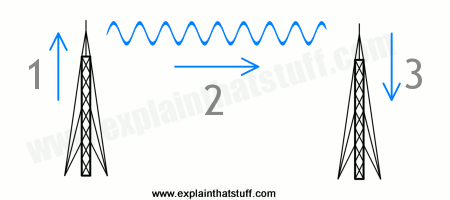
http://www.explainthatstuff.com/radio.html
Radio waves are part of a larger group of waves (or ways of sending energy through space) classified all together as electromagnetic radiation. This radiation is in the air all around us and it is what makes sending a signal from one place to another possible.
Electromagnetic Radiation
Radios and radio communication have played a vital role since their invention in the late 1800s by Marconi. Radio waves that power radio communication are one end of the Electromagnetic Spectrum. The radio wave is invisible but is characterised by its length, its frequency, its intensity and whether its analog or digital. Our radios catch the signal sent from the radio station and decode the message.
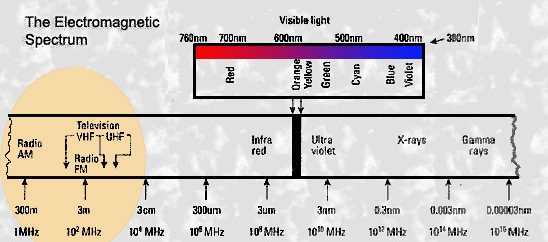
Image Source http://www.cybercollege.com
Radio Waves
Radio waves used for communication range in size from 1 millimeter (0.04 inches) to more than 100 kilometers (62 miles). The following picture shows the difference between AM, FM and TV wavelengths.

Image Source http://science.hq.nasa.gov
Interference
If the air becomes overcrowded with waves then there can be interference.
You may have noticed your radio flickering when you turned on the microwave. Microwaves are close in size to radio waves on the electromagnetic spectrum. Your radio flickers because the air has become overcrowded with radio waves.
Overcrowding interference is what distinguishes the use of different frequencies and types of broadcast.
Tip: If you live in an apartment and get a lot of interference on the WIFI make sure your WIFI uses the 5GHz band which is less common and has less interference than the older 2.4GHz band
Licensing
Just think of all the uses for radio communication; Radio Stations, TV stations, Mobile Phones, Walkie Talkies, Ships, Trucks, Cops, Emergency Services...
For this reason limits were put on who uses the airwaves. In most countries the air is licensed by the government with limits put on who can use certain wavelengths and for what. Interference causes you problems in your kitchen but it would cause huge issues for broadcasters if other stations were broadcasting on the same frequency or even on a frequency that was close to their one.
Analogue Waves
Analogue waves differ from Digital waves in that each wave carries one piece of information all of which needs to reach the receiver. There can be different intensities and the data is not encoded.
AM and SW Waves
These travel along the ground and are reflected (technically refracted) by the ionosphere. But the are very low intensity so generally only travel short distances and are not as clear as FM rays.
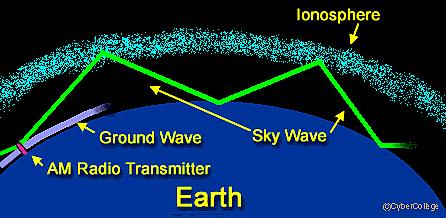
Image Source: http://www.cybercollege.com/
FM and TV Waves
These waves go in a straight line and don't bend around the earth as AM ground waves do. Thus, they can quickly disappear into space. This is the problem in Norway. Due to the landscape which is full of Fjords and valleys a lot of repeater stations are needed so that FM radio is available everywhere.
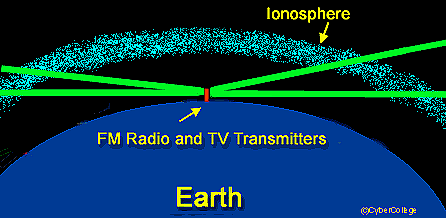
Image Source: http://www.cybercollege.com/
Digital Waves
These are signals sent our like AM and FM but with much longer wavelengths and the data is sent in packets which then need to be decoded by the digital radio receiver. Unlike Analogue Waves each packet in a Digital Wave may be sent multiple times so there can be some loss in data or interference without any loss in quality.
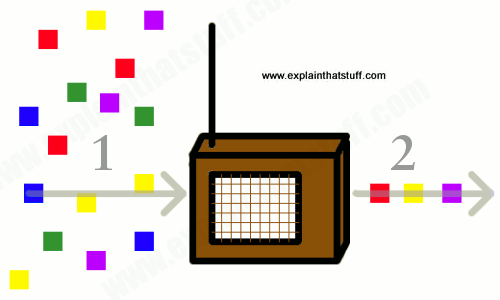
Image Sournce http://cdn4.explainthatstuff.com/
See the difference between Digital and Analogue
Put a digital radio and an ordinary analogue radio next to one another and tune them both into the same station. You'll find the sound from the digital radio lags noticeably behind the sound from the analogue radio because of the time it takes to reassemble the digital signal.
Thank you for reading this. I write on Steemit about Blockchain, Cryptocurrency, Travel and lots of random topics.
Great article, including a healthy touch of education in it too. Thanks a bunch, it is excellent! Upvoted!!! Namaste :)
Thank you.
Great article! Steem Radio is 24/7 Live! online so no problem for us :)
THis is awesome man! Cool stuff!
Learning new things is the best!
You might be interested in some of the sites I came across when I was researching this post. Check out http://www.cybercollege.com/
Beautifully researched, presented, and illustrated article. Not just a bit of news, but an education in a short and interesting capsule. Thank you very much! Following you now... 😄😇😄

Thank you. Very encouraging feedback.
I use posts like this as an opportunity to research some topics in detail. Part of what makes Steemit great for me is the opportunity to put some structure on my ideas and random thoughts and learn some new things along the way. There are so many great articles on every topic imaginable. Well written and insightful.
Maybe its not Facebook that should be afraid of Steemit but Universities :)
Following you now too :)
Hey @eroche, Thank You for your very informative response! :)
I think you're absolutely right! ;) I am looking forward to exploring your blog and reading more. Likewise, I invite you to explore mine; I've tried to make it easy - just click on the GIF in my first Reply above, and I think you'll see what I mean. ;) Appreciate the follow, I hope you'll enjoy my posts and that we'll be able to interact on matters of mutual interest. :)
I look forward to it :)
What is about health issues ? A new technology broadcasting digital signals along the other artificial frequencies could have a negative side effect on our heath. I think that should be considered ! But nobody speaks about.
Well much like analogue television, we should let go of the past and embrace newer and better technologies.
Totally! We need to live in the future, not in the past ^^
I completely agree. I still used to listen to matches on FM. It still had it's uses
Exactly! It does, but only because we hang on to it. We can port the same content to a digital format and use modern technology to make it just as accessible, and perhaps even increase quality. I think getting good digital radio-like sports content is something that people would like a lot. I know I would.
I think there's many cars still using FM, most actually. This would mean people would have to upgrade their car radio or start listening to CD's, if their current radio is equipped for that. And what about work places? There's enough around that just use a cheap FM radio to listen to some tunes in the background.
I can definitely understand this decision being badly received.
CDs or streaming radio :)
I agree that streaming is nice when driving, but remember that we have a lot of bad weather here in Norway. If I am to cross one of the large mountain ranges in winter, I for sure want to listen to the radio on the way there to make sure it is still open for driving etc.
Speaking as a Norwegian who is currently experiencing these issues; the car radios are a big problem. The government simply urges people to buy adapters, which are not all that expensive, so I think that is what most people are doing.
Here in the U.S., both FM and AM are common (AM is usually stuff like talk radio and sports). While TV stations all moved to digital several years ago, I haven't hear anything about analog FM and AM going away even though satellite and HD radio are available.
I agree with @justtryme90 and am all for embracing new technology :) Where I am from AM is not used at all and everything is broadcast on FM. It will be a big change for some countries and not so big a change for others I think.
Great post. The very issue is that DAB is using mp2, while DAB+ is using AAC as a codec. This means, when you say "we now go for DAB" , you are creating the issue of having a proper receiver.
Your right you now get all compatibility issues and even copyright issues if certain codecs are used. What annoys me about digital is when your at a match listening to it on the radio, there is a delay with digital and that's even if it works in a crowded stadium. :(